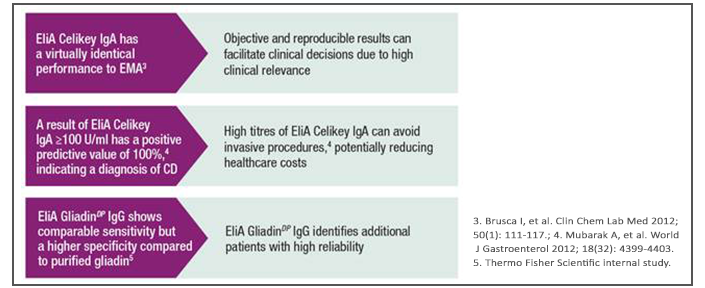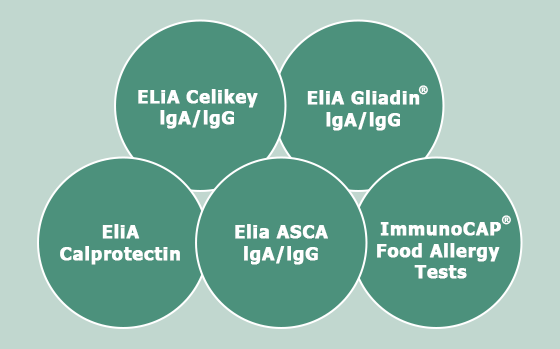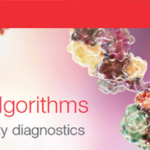EliA Celikey (tTG) and GliadinDP – Best in class for diagnosis of coeliac disease
Celiac disease is a chronic and multiorgan autoimmune disease that affects the small bowel in genetically predisposed persons due to the ingestion of gluten1. It can present a wide range of symptoms such as anemia, vague abdominal symptoms, esophagitis, neuropathy, ataxia, depression, short stature, osteomalacia, and multiple others.1 For the majority of patients, their celiac disease remains undiagnosed.1
The EliA Coeliac portfolio offers a best-in-class, workflow optimised testing algorithm to aid in the diagnosis of celiac disease.1-3
Best-in-class tissue transglutaminase IgA test
With a specificity of 98.5%, EliA Celikey IgA test is the most clinically relevant, fully automated, tissue transglutaminase IgA test. This allows for optimal patient testing by identifying more subjects suffering from celiac disease, correctly, the first time.4
Helping reduce endoscopies
The European Society for Paediatric Gastroenterology, Hepatology, and Nutrition (ESPGHAN) 2019 guidelines for the diagnosis of celiac disease state that if an anti-tissue transglutaminase antibody test result is greater than 10 times the manufacturers upper limit of normal range (ULN), then endoscopy can be avoided in favor of confirmatory endomysial antibody (EMA) testing.2
To demonstrate the validity of the ESPGHAN guidelines to conditionally omit biopsies, a prospective multicenter study was performed.5 In this study, it was demonstrated that with a PPV of 99% at just 2 x ULN (20 EliA U/ml) and a PPV of 100% at just 5 x ULN (50 EliA U/ml), the EliA Celikey IgA test may help reduce endoscopies more than any other automated assay. 5
The combination of EliA Celikey IgA and EliA GliadinDP IgG leads to high sensitivity with exceptional specificity in all patient groups, increasing the number of CD patients diagnosed.
EliA comprehensive panel of gastrointestinal tests provides clear guidance, from gastrointestinal symptoms to clinical diagnosis.
References
- Al-Toma A, Volta U, Auricchio R, Castillejo G, Sanders DS, Cellier C, et al. European Society for the Study of Coeliac Disease (ESsCD) guideline for coeliac disease and other gluten-related disorders. United European Gastroenterol J. 2019;7(5):583-613.
- Husby S, Koletzko S, Korponay-Szabo I, Kurppa K, Mearin ML, Ribes-Koninckx C, et al. European Society Paediatric Gastroenterology, Hepatology and Nutrition Guidelines for Diagnosing Coeliac Disease 2020. J Pediatr Gastroenterol Nutr. 2020;70(1):141-56.
- Rubio-Tapia A, Hill ID, Kelly CP, Calderwood AH, Murray JA, American College of G. ACG clinical guidelines: diagnosis and management of celiac disease. Am J Gastroenterol. 2013;108(5):656-76; quiz 77.
- Vermeersch P, Geboes K, Marien G, Hoffman I, Hiele M, Bossuyt X. Serological diagnosis of celiac disease: comparative analysis of different strategies. Clin Chim Acta. 2012;413(21-22):1761-7.
- Werkstetter KJ, Korponay-Szabo IR, Popp A, Villanacci V, Salemme M, Heilig G, et al. Accuracy in Diagnosis of Celiac Disease Without Biopsies in Clinical Practice. Gastroenterology. 2017;153(4):924-35.









